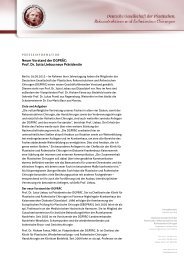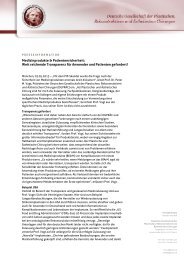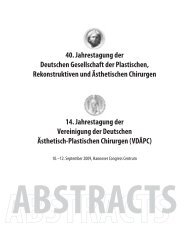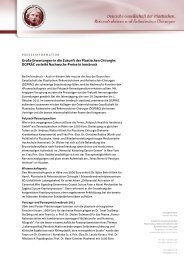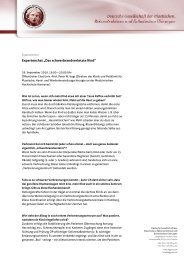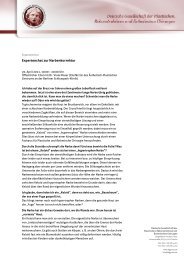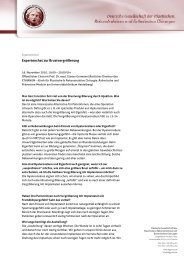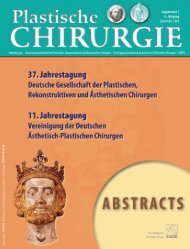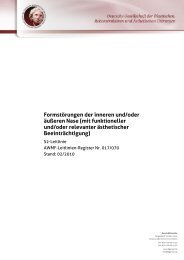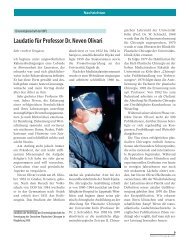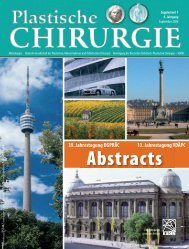ABSTRACTS
ABSTRACTS
ABSTRACTS
Sie wollen auch ein ePaper? Erhöhen Sie die Reichweite Ihrer Titel.
YUMPU macht aus Druck-PDFs automatisch weboptimierte ePaper, die Google liebt.
34. Jahrestagung der Deutschen Plastischen Chirurgen<br />
8. Jahrestagung der Deutschen Ästhetisch-Plastischen Chirurgen<br />
P15 Platelet kinetics in the microcirculation of muscle flaps<br />
after ischemia/reperfusion-a novel mouse model<br />
S. Langer, C. Kim, M. Tränkle, O. Goertz, M. Koller, H.U. Steinau, H.H. Homann<br />
Dept. of Plastic and Hand Surgery, Burn Center, BG Trauma Center, Ruhr University Bochum<br />
Growing evidence supports the substantial pathophysiological impact of<br />
platelets on the development of ischemia/reperfusion injury (i/r) in flaps<br />
and replanted body parts. Methods for studying these cellular mechanisms<br />
in vivo are not present yet. The aim of this study was to develop a<br />
model enabling the quantitative analysis of platelet kinetics and plateletendothelium<br />
interaction within consecutive segments of the microcirculation<br />
of muscle flaps in vivo.<br />
Materials and Methods: Female mice (balb/c; two groups, each n=8) were<br />
anesthetized, a muscle flap was prepared and placed onto an observation<br />
platform. Autologous platelets were separated from a blood donor animal<br />
(n=8) and labelled ex vivo by means of r6G. After ischemia (90 min clamping)<br />
and reperfusion (10 min) the labelled platelets were given i.v.<br />
Microhemodynamics and kinetics of platelets were investigated by intravital<br />
fluorescent microscopy. Velocities of red blood cells (RBCV) and platelets<br />
were measured and the number of platelets rolling and adhering to<br />
the microvascular endothelium was counted.<br />
Results: The novel model allows direct visualization and analysis of platelet<br />
dynamics in the microcirculation of flaps in vivo. As expected, i/r of<br />
muscle flaps induced disturbances of the microcirculation (RBCV). Platelets<br />
adhering to the inner vessel wall of venules increased in the ischemia<br />
group (8(0,7, vs 0 control; mean/sem). Rolling platelets were only<br />
found after ischemia (14,7(1,5 vs 0).<br />
In conclusion, using intravital fluorescent microscopy platelet kinetics<br />
were directly analyzed in the flap microcirculation in vivo for the first<br />
time. Since platelet/endothelium interaction is key in the pathophysiology<br />
of a failing flap this model will help to understand basic molecular<br />
principles of i/r. Therapeutic strategies to protect flaps from i/r will soon<br />
be evaluated using this model.<br />
P16 Die Induktion von Hämoxygenase-1 inhibiert die<br />
mikrovaskuläre Thrombusformation in vivo<br />
N. Lindenblatt1,2 , R. Bordel1 , W. Schareck2 , M.D. Menger3 , B. Vollmar1 1 2 Abteilung für Experimentelle Chirurgie, Abteilung für Allgemeinchirurgie, Universität Rostock,<br />
3Institut für Klinisch-Experimentelle Chirurgie, Universität des Saarlandes, Homburg/Saar<br />
Der postischämische Reperfusionsschaden nach freiem Gewebetransfer<br />
beruht wesentlich auf einer Bildung reaktiver Sauerstoffverbindungen,<br />
welche zu einer erhöhten Thrombogenität im mikrovaskulären Gefäßsystem<br />
führen. Der Einsatz antioxidativer Substanzen könnte somit zur<br />
Verminderung des Gewebeschadens nach freien Lappenplastiken beitragen.<br />
Das Enzym Hämoxygenase (HO) katalysiert den letzten Schritt des<br />
Abbaus von Häm mit Freisetzung äquimolarer Mengen an Eisen, antioxidativem<br />
Biliverdin und vasodilativem Kohlenmonoxid (CO). Die<br />
nicht-konstitutive Isoform (HO-1) wird u.a. durch oxidativen Stress und<br />
inflammatorische Stimuli im Sinne einer Gegenregulation zur Gewebeprotektion<br />
induziert. Ziel der hier vorliegenden Studie war zu klären,<br />
inwieweit die Expression von HO-1 die Bildung mikrovaskulärer Thromben<br />
moduliert und damit die Athrombogenität des Endothels erhöht werden<br />
kann.<br />
Im Modell der Kremastermuskelpräparation der Maus wurde die Kinetik<br />
der Bildung von, durch Superfusion mit FeCl3 induzierten, mikrovaskulären<br />
Thromben mittels intravitaler Fluoreszenzmikroskopie<br />
quantitativ analysiert. Nach Vorbehandlung mit Hämin (50 µM/kg ip, -<br />
18hr) konnte im Kremastermuskel mittels Western Blot Analyse eine<br />
Plastische Chirurgie 3 (Suppl. 1): 57 (2003)<br />
Abstracts<br />
deutliche Induktion von HO-1 Protein nachgewiesen werden. Parallel<br />
dazu zeigten immunhistochemische Untersuchungen des Muskelgewebes<br />
eine präferentielle Expression von HO-1 im Endothel und den glatten<br />
Muskelzellen der Gefäße. Bei diesen Tieren war die Bildung arteriolärer<br />
und venulärer Thromben (komplette Stase: 670±96s bzw.<br />
647±129) signifikant (p





